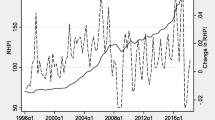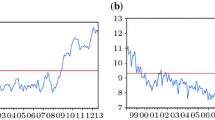Abstract
This paper examines two questions about the temporal stability of the price discovery relationship using data from Hong Kong. We first study the extent to which abnormally large returns (positive or negative) to securitized real estate are transferred to the returns in the direct real estate market. Our regressions show that price discovery is much reduced in the period following a news event. They show that the estimate of the long run price discovery effect also is reduced once we control for news effects. The second question we examine is whether the price discovery relationship is stable over time. The evidence appears to indicate that the post-1994 period was different from the preceding period. The change in the strength of the price discovery effect may be linked to a change in banking regulations in February 1994 that limited banks' risk exposure to real estate loans by capping them at 40 percent of total lending or to anti-speculative measures introduced by the government in the second quarter of 1994 to curb speculation in the residential market. Our statistical tests of structural stability give mixed results and are therefore inconclusive. These findings suggest that the size of the price discovery effect depends upon the amount of real estate information embedded in the history of securitized returns. The findings further suggest that the securitized return series itself may be an incomplete measure of the quantum of information.
Similar content being viewed by others
References
Ambrose, B. E., and P. Linneman. (1999). “The Maturation of REITs,” Wharton Real Estate Review 3(2), 37-45.
Barkham, R., and D. Geltner. (1995). “Price Discovery in American and British Property Markets,” Real Estate Economics 23, 21-44.
Brown, G. (1991). Property Investment and Capital Markets. London: E. & F. N. Spoon.
Brueggeman, W. B., A. H. Chen, and T. Thibodeau. (1984). “Real Estate Investment Funds: Performance and Portfolio Considerations,” AREUEA Journal 12(3), 333-354.
Campbell, J. Y., A. W. Lo, and A. C. MacKinlay. (1997). The Econometrics of Financial Markets. Princeton: Princeton University Press.
Chau, K. W., B. D. MacGregor, and G. M. Schwann. (2001). “Price Discovery in the Hong Kong Real Estate Market,” Journal of Property Research 18(3), 187-216.
Darrat, A. F., and J. L. Glascock. (1989). “Real Estate Returns, Money and Fiscal Deficits: Is the Real Estate Market Efficient?” Journal of Real Estate Finance and Economics 2(3), 197-208.
Darrat, A. F., and J. L. Glascock. (1993). “On Real Estate Efficiency,” Journal of Real Estate Finance and Economics 7(1), 55-72.
Fama, E. F., and M. R. Gibbons. (1982). “Inflation, Real Returns and Capital Investment,” Journal of Monetary Economics 9, 297-323.
Fama, E. F., and G. W. Schwert. (1977). “Asset Returns and Inflation,” Journal of Financial Economics 5, 115-146.
Ganesan, S., and Y. H. Chiang. (1998). “The Inflation Hedging Characteristics of Real and Financial Assets in Hong Kong,” Journal of Real Estate Portfolio Management 4(1), 55-68.
Giliberto, S. M. (1990). “Equity Real Estate Investment Trusts and Real Estate Returns,” Journal of Real Estate Research 5(2), 259-264.
Giliberto, S. M. (1993). “Measuring Real Estate Returns: The Hedged REIT Index,” Journal of Portfolio Management 19(3), 94-99.
Glascock, J. L., C. Lu, and R. W. So. (2000). “Further Evidence on the Integration of REIT, Bond, and Stock Returns,” Journal of Real Estate Finance and Economics 20(2), 177-195.
Hong Kong Monetary Authority. (2000). Asset Pricing and Central Bank Policies: The Case of Hong Kong, http://www.info.gov.hk/hkma/eng/public/qb9805/qbfa03e.htm, Sept. 1, 2000.
Limmack, R. J., and C. W. R. Ward. (1988). “Property Returns and Inflation,” Land Development Studies 5(3), 47-55.
Liu, C. H., D. J. Hartzell, and M. E. Hoesli. (1997). “International Evidence on Real Estate Securities as an Inflation Hedge,” Real Estate Economics 25(2), 193-221.
Myer, F. C. N., and J. R. Webb. (1993). “Return Properties of Equity REITs, Common Stocks and Commercial Real Estate: A Comparison,” Journal of Real Estate Research 8(1), 87-106.
Newell, G. (1995). “Inflation-Hedging Attributes of Australian Commercial Property,” School of Land Economy, University of Western Australia.
Newell, G., and K. W. Chau. (1996). “Linkages Between Direct and Indirect Property Performance in Hong Kong,” Journal of Property Finance 7(4), 9-30.
Schwann, G. M., and B. D. M. MacGregor. (2000). “Temporal and Spatial Variations in Market Liquidity, Appraisal Smoothing and Price Discovery in Private and Public Real Estate Markets.” Working Paper, Real Estate Research Unit, University of Auckland.
Author information
Authors and Affiliations
Rights and permissions
About this article
Cite this article
Schwann, G.M., Chau, K.W. News Effects and Structural Shifts in Price Discovery in Hong Kong. The Journal of Real Estate Finance and Economics 27, 257–271 (2003). https://doi.org/10.1023/A:1024732521745
Issue Date:
DOI: https://doi.org/10.1023/A:1024732521745




